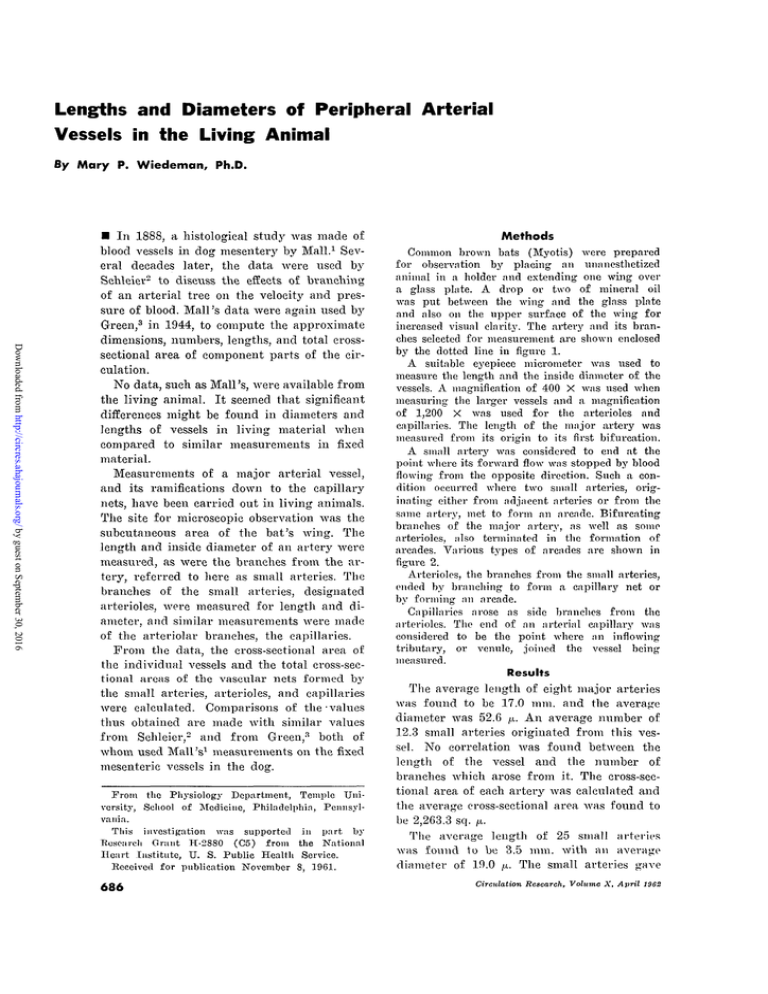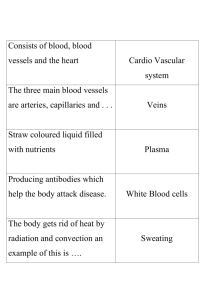
Lengths and Diameters of Peripheral Arterial
Vessels in the Living Animal
By Mary P. Wiedeman, Ph.D.
Downloaded from http://circres.ahajournals.org/ by guest on September 30, 2016
• In 1888, a histological study Avas made of
blood vessels in dog mesentery by Mall.1 Several decades later, the data were used by
Schleier2 to discuss the effects of branching
of an arterial tree on the velocity and pressure of blood. Mall's data were again used by
Green,3 in 1944, to compute the approximate
dimensions, numbers, lengths, and total crosssectional area of component parts of the circulation.
No data, such as Mall's, were available from
the living animal. It seemed that significant
differences might be found in diameters and
lengths of vessels in living material when
compared to similar measurements in fixed
material.
Measurements of a major arterial vessel,
and its ramifications down to the capillary
nets, have been carried out in living animals.
The site for microscopic observation was the
subcutaneous area of the bat's wing. The
length and inside diameter of an artery were
measured, as were the branches from the artery, referred to here as small arteries. The
branches of the small arteries, designated
arterioles, were measured for length and diameter, and similar measurements were made
of the arteriolar branches, the capillaries.
From the data, the cross-sectional area of
the individual vessels and the total cross-sectional areas of the vascular nets formed by
the small arteries, arterioles, and capillaries
were calculated. Comparisons of the values
thus obtained are made with similar values
from Schleier,2 and from Green,3 both of
whom used Mall's1 measurements on the fixed
mesenteric vessels in the dog.
From the Physiology Department, Temple University, School of Medicine, Philadelphin, Pennsylvania.
This investigation was supported in part by
Research Grant H-2880 (Co) from the National
Heart Institute, TJ. S. Public Health Service.
Received for publication November 8, 1961.
686
Methods
Common brown bats (Myotis) were prepared
for observation by placing an unanesthetized
animal in a, holder and extending' one wing over
a glass plate. A drop or two of mineral oil
was put between the wing and the glass plate
and also on the upper surface of the wing for
increased visual clarity. The artery and its branches selected for measurement are shown enclosed
by the dotted line in figure 1.
A suitable eyepiece micrometer was used to
measure the length and the inside diameter of the
vessels. A magnification of 400 X was used when
measuring the larger vessels and a magnification
of 1,200 X was used for the arterioles and
capillaries. The length of the major artery was
measured from its origin to its first bifurcation.
A small artery was considered to end at the
point where its forward flow was stopped by blood
flowing from the opposite direction. Such a condition occurred where two small arteries, originating either from adjacent arteries or from the
same artery, met to form an arcade. Bifurcating
branches of the major artery, as well as some
arterioles, also terminated in the formation of
arcades. Various types of arcades are shown in
figure 2.
Arterioles, the branches from the small arteries,
ended by branching to form a capillary net or
by forming an arcade.
Capillaries arose as side brandies from the
arterioles. The end of an arterial capillary was
considered to be the point where an inflowing
tributary, or venule, joined the vessel being
measured.
Results
The average length of eight major arteries
was found to be 17.0 mm. and the average
diameter was 52.6 p.. An average number of
12.3 small arteries originated from this vessel. No correlation was found between the
length of the vessel and the number of
branches which arose from it. The cross-sectional area of each artery Avas calculated and
the average cross-sectional area was found to
be 2,263.3 sq. p.
The average length of 25 small arteries
was found to be 3.5 mm. with an average
diameter of 19.0 /x. The small arteries gave
Circulation Research, Volume X, April 19G2
687
PERIPHERAL ARTERIAL VESSELS
MAIN ARTEf t r
Downloaded from http://circres.ahajournals.org/ by guest on September 30, 2016
FIGURE 2
Various types of arterial arcades.
FIGURE 1
Area in the bat wing used for measurements, of
a major arterial vessel and its ramifications.
rise to an average number of 9.7 branches,
the arterioles. An average of the individual
cross-sectional area of small arteries was
found to be 337.7 sq. /x and the total crosssectional area of these vessels was calculated
to be 4,144.5 sq. JX.
The average values for arterioles, based on
measurements in 15 vessels, were 0.95 mm.
for length, 7.0 JX for diameter, and 42.7 sq. JX
for individual cross-sectional area with a total
cross-sectional area for the vessels of 5,101.2
sq. jx. Arterioles gave rise to an average number of 4.6 capillaries.
The average values for the capillaries, based
on measurements of 24 vessels, showed the
length to be 0.23 mm. and the diameter to
average 3.7 p.. The individual cross-sectional
area was 11.7 sq. /X, while the total cross-sectional area was 6,548.1 sq. JX.
The relationships between the lengths and
diameters of the vessels can be seen in figure
3. The arterioles are roughly twice the diameter of the capillaries and almost one-half the
diameter of the small arteries. The small
arteries are less than one-half the diameter
of their parent vessel. Comparison with the
diameters of similar vessels, reported by
Circulation Research, Volume X, April 1962
Schleier,2 show a different relationship. The
arterioles have a diameter roughly three times
that of the capillaries and are many times
smaller than the terminal branches from
which they arise (see fig. 4).
The total cross-sectional areas produced by
division of the vessels in the various portions
of the arterial bed of the bat wing show a
linear increment from artery to capillary (see
fig. 5). These values differ greatly from those
obtained when Mall's1 data were used for
computation by Schleier,2 and by Green?
There is a very small increment in total crosssectional area between artery and small arteries, a slightly larger increase in area between small arteries and arterioles, and a
very marked increase in area between arterioles and capillaries. It is very likely that
the measurements on fixed sections of the dog
mesenteric vessels included many more capillary vessels than were counted in the living
bat wing. The tremendous number of capillary vessels reported for the dog mesentery
would be a possible result if the termination
of arterial capillaries could not be established
due to the absence of blood flow. The great
difference in the number of vessels reported
for the various types results in a wide variance in the calculated total cross-sectional
area.
A comparison of the calculated total crosssectional areas from Schleier,2 and from
Green,3 and from the bat wing at the level
688
WIEDEMAN
r\
FIGURE 3
Lengths and diameters of various arterial blood vessels in the living bat.
Downloaded from http://circres.ahajournals.org/ by guest on September 30, 2016
iUJ
Z
FIGURE 4
Comparison of the diameters of blood vessels in the living bat (MPW) and fixed
tissues in the dog (JS).
of the artery, small arteries, arterioles, and
capillaries is shown in figure 6.
Discussion
It was an expected finding that the actual
values of length and diameter of the various
arterial vessels would be different in the bat
wing and the dog mesentery. However, it is
the disagreement in the relationship between
the vessels that is of importance. The basis
of the disagreement is certainly to be found
in the difference between measurements made
in the fixed preparation and the living animal.
There are many difficulties associated with
Circulation Research, Volume X, April 1962
689
PERIPHERAL ARTERIAL VESSELS
Downloaded from http://circres.ahajournals.org/ by guest on September 30, 2016
FIGURE 5
Increase in total cross-sectional area from artery to capillary. Comparative lengths
of the vessels are also shown.
TOTAL CROSS-SECTIONAL
2
AREA
<
g
=
<
o
FIGURE 6
Comparison of computed total cross-sectional areas from the living bat (MPW),
from Schleier (JS), and from Green (HDG), who used Mall's measurements on
fixed mesenterie vessels in the dog.
Circulation Hcsaarch, Volume X, April 1962
WIEDEMAN
690
Downloaded from http://circres.ahajournals.org/ by guest on September 30, 2016
measuring vessels in a fixed preparation, for
there is undoubtedly much distortion in the
size of vessels subjected to histological preparation. A further difficulty is the inability
to classify accurately a vessel in which there
is no blood flow. It is also reasonable to assume that the figures given by Schleier,2 and
by Green,3 for the numbers of small arteries,
arterioles, and uapillai-ies in the fixed preparation are hardly more than a rough estimate. However, this value is important in
calculating the total cross-sectional areas
formed by these vessels.
The selection of the subcutaneous area of
the bat's wing as a representative site for
vascular measurements may provoke criticism.
In defense, the vascular pattern seen in the
bat wing is comparable to subcutaneous beds
described in other animals. Actually, the pattern is a familiar one, being very similar to
vascular beds seen in a variety of tissues.
Also, it is possible to follow blood flow in this
preparation in its complete circuit from distributing artery to collecting vein.
Green3 has pointed out that his data obtained from computing the dimensions, numbers, lengths, and total cross-sectional area of
the component parts of the circulation from
Mall's1 original work on the dog's mesenteric
vessels are very rough, since many assump-
tions were necessary. The values reported
here are the result of direct microscopic observation in living tissue. Assumptions are
limited to the use of average values obtained
from a large sample.
Summary
Measurements of the length, diameter, and
number of branches of arterial vessels were
made from a distributing artery to the capillaries in a living bat. From the values so
obtained, cross-sectional areas in various portions of the arterial bed were calculated. An
almost linear decrease in the diameters of
successively smaller vessels was found. There
was also a linear relationship in the calculated
total cross-sectional areas formed by the various vessels. The results are not in agreement
with similar reports made by others using
measurements from vessels in a fixed preparation.
References
1. MALL, F.: Die Blut und Lymphwege im Dunndarm des Hundcs. In Koniglich Sachsschen
Gesellschaft der Wissenschaft. Abhandlungen
der Mathematisch-physischen Classe. Vol. XIV,
1888.
2. SOHLEIEE,
J.:
Der
Energievebriuich
in
der
Blutbahn. Arch. ges. physiol. 173: 172, 1918.
3. GKEEN, H. D.: Circulation; physical principles.
In Medical Physics, edited by 0. Glasser.
Chicago, Tear Book Publishers, 1944.
Circulation Research, Volume X, April 1962
Lengths and Diameters of Peripheral Arterial Vessels in the Living Animal
Mary P. Wiedeman
Downloaded from http://circres.ahajournals.org/ by guest on September 30, 2016
Circ Res. 1962;10:686-690
doi: 10.1161/01.RES.10.4.686
Circulation Research is published by the American Heart Association, 7272 Greenville Avenue, Dallas, TX 75231
Copyright © 1962 American Heart Association, Inc. All rights reserved.
Print ISSN: 0009-7330. Online ISSN: 1524-4571
The online version of this article, along with updated information and services, is located on the
World Wide Web at:
http://circres.ahajournals.org/content/10/4/686
Permissions: Requests for permissions to reproduce figures, tables, or portions of articles originally published in
Circulation Research can be obtained via RightsLink, a service of the Copyright Clearance Center, not the
Editorial Office. Once the online version of the published article for which permission is being requested is
located, click Request Permissions in the middle column of the Web page under Services. Further information
about this process is available in the Permissions and Rights Question and Answer document.
Reprints: Information about reprints can be found online at:
http://www.lww.com/reprints
Subscriptions: Information about subscribing to Circulation Research is online at:
http://circres.ahajournals.org//subscriptions/





